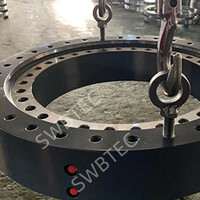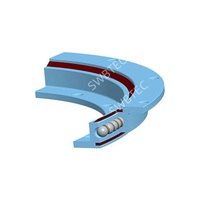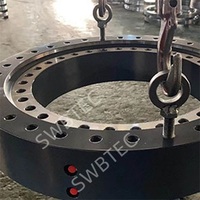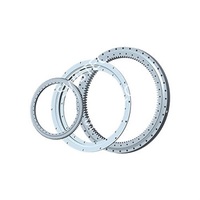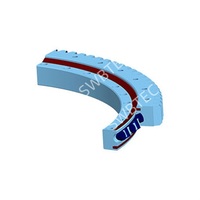Double Row Ball Slewing Bearing
Specifications
Double row slewing bearing usually include same size rolling element and different size rolling element. The heavy duty ball bearing turntable is composed with two rows ball which can bear much
higher axial, radial and overturning moment that is widely used on heavy equipment, like mining equipment and large crawler crane. As one of the professional slew ring bearing manufacturers, SWBTEC
double row slewing bearing has been assembled on many customer's machine, and have received high reputation from end user, as we can help the end user to maximize their machine and provide timely
and effective after-sales service and technical support of the ball bearing swing.
Double Row Ball Slewing Bearing Features and Benefits
SWBTEC recommend customers to choose double-row slewing bearing according to the customer's requirements for bearing load capacity.
The double row ball slewing bearing can withstand larger axial loads, appropriate radial loads and overturning moments. Compared with three-row slewing bearings, the double row slewing bearing can
lower procurement costs for customers.
The three row roller slewing bearing meets the requirements of small size and large load. However, when the eccentricity of the axial load is relatively small, the bearing capacity of the three-row
slewing bearing is rich and the cost is relatively high.
Our company engineers have strong product design capabilities, please feel free to contact us if you need double row slewing bearing.
Double Row Ball Slewing Bearing Application
Double row slewing bearing is a kind of slewing bearing which is used on ship cranes. There are generally 4 pieces of slewing bearings on ships to share the loading and unloading operations of the
ship, and the service life is generally required to be 6-10 years. Therefore, it is very important to ensure the reliability and durability of the slewing bearings.
The characteristics of marine slewing bearings are high flexibility, and relatively high rotational speed and the load is generally between 15-30 tons, so four-point contact ball bearings are
widely used. But what are the design features and advantages of single-row and double-row ball bearings?
First of all, the height of the single row ball slewing bearing should be high, and the steel ball should be 60-70mm to ensure that the bearing capacity is competent and the sealing performance is
better. In the early use of the bearing, the application is very high, and the user feedback is good. The characteristic is that the height is high and the steel ball is enlarged, which improves
the rigidity and strength of the bearing and is a very good choice.
The double row ball bearing is based on the consideration of flexibility of the slewing bearing, and the structural consideration which increased to reduce the excessive fatigue of the raceway and
the steel ball, thereby improving the life and stability of the slewing bearing. The design considerations are perfect, but the application process is flawed, and the raceway force sometimes
appears eccentric.
Combining the slewing bearings of the two structures, because the starting points are slightly different, they both have a good and stable record on the ship crane. From the feedback, the
advantages and disadvantages are not obvious, and both structures are still good choices. Of course, the price of double-row slewing bearings is significantly higher than that single-row slewing
bearings.
Installation requirements for the double row slewing bearings
Ensure Cleanliness:
Before installation, make sure the mounting surfaces and mating components are clean and free from debris, dirt, or other contaminants that could affect the bearing's performance.
Proper Alignment:
Ensure accurate alignment of the double row slewing bearing with the mating components. Misalignment can lead to increased stress, premature wear, and reduced bearing life.
Torque Specifications:
Follow the manufacturer's recommended torque specifications for tightening the mounting bolts. Over-tightening can cause excessive preload, while under-tightening can lead to looseness and
misalignment.
Lubrication:
Apply the appropriate lubricant to the surfaces of double row ball bearing during installation. Follow the manufacturer's recommendations for the type and quantity of lubricant to be used.
Adequate lubrication helps reduce friction, minimize wear, and dissipate heat effectively.
Double Row Slewing Bearing FAQs
QHow does a double row slewing bearing differ from a single row slewing bearing?
A ball bearing swing differs from a single row slewing bearing in terms of its structure and load-carrying capacity. Here are the key differences between the two:
Structure: A single row slewing bearing consists of a single row of rolling elements (typically balls or rollers) placed between two rings. In contrast, a double row slewing bearing has two rows of
rolling elements, with each row positioned between two rings. This arrangement provides increased load-carrying capacity and improved stability.
Load Capacity: Due to the presence of two rows of rolling elements, a double ball bearing turntable can handle significantly higher axial, radial, and moment loads compared to a single row slewing
bearing. The additional row of rolling elements distributes the load more evenly, resulting in enhanced load-bearing capabilities.
Stiffness and Stability: The double row configuration improves the stiffness and stability of the slewing bearing. It offers increased resistance to deformation and deflection under heavy loads.
QCan double row slewing bearings be customized for specific applications?
Yes, double row ball slewing bearing can be customized to meet specific application requirements. Customization allows for the adaptation of the bearing's design, size, load capacity, sealing
options, lubrication, and other features to suit the unique needs of different industries and applications.
QHow do I determine the appropriate size of a double row slewing bearing for my application?
Load Requirements: Determine the maximum axial, radial, and moment loads that the slewing bearing will need to support in your application. This includes both static and dynamic loads. It's
crucial to accurately calculate the loads to ensure the bearing can handle the anticipated forces.
Operating Conditions: Consider the operating conditions such as speed, temperature, and environmental factors. Higher speeds or extreme temperatures may require special considerations in bearing
selection.
Mounting Space: Evaluate the available space for installing the slewing bearing. Consider the outer diameter, inner diameter, and overall dimensions of the bearing to ensure it fits within the
designated area.
Bearing Geometry: Heavy duty ball bearing turntable comes in various geometries and designs. Evaluate the specific geometry options available and choose one that best suits your application
requirements.
QWhat are the recommended maintenance practices for double row slewing bearings?
Regular Inspections: Conduct regular visual inspections of the double row slewing bearing to check for signs of wear, damage, or corrosion. Look for abnormal noise, vibration, or temperature
changes that may indicate potential issues.
Lubrication Maintenance: Monitor the lubrication condition and replenish or replace the lubricant as needed. Ensure the lubrication intervals and quantities are in accordance with the
manufacturer's recommendations.
Seal Integrity: Check the seals and gaskets regularly to ensure ball bearing swing is intact and provide effective protection against contaminants. Replace any damaged or worn seals promptly
Load Distribution: Periodically inspect the mounting bolts and connections to ensure they remain tight and secure. Uneven loading or loose connections can lead to stress concentration and premature
failure.
Environmental Considerations: If the double row ball slewing bearing operates in harsh or extreme environments, take additional precautions. For example, in corrosive environments, consider using
corrosion-resistant coatings or materials and implement appropriate sealing measures.
- Country: Afghanistan
- Contact: ngswb tec

